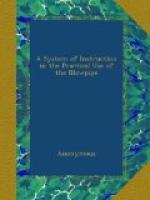* * * * *
Mineral. Emerald nickel
Formula. [.Ni]^{3}[..C] + 6[.H].
Behavior
(1) in glass-bulb. Gives off much water and turns black.
(2) in open tube. —
(3) on charcoal. —
(4) in forceps. —
(5) in borax. Dissolves
with much effervescence and gives the
nickel
reaction.
(6) in mic. salt. As in borax.
(7) with carb. soda. Forms a slaggy mass.
(8) Special reactions. In warm dilute
HCl dissolves with much
effervescence.
* * * * *
Mineral. Cobalt Bloom
Formula. [.Co]^{3}[.....As] + 8[.H].
Behavior
(1) in glass-bulb. Gives off water.
(2) in open tube. —
(3) on charcoal. Evolves arsenical
fumes and in the reducing
flame
fuses to a dark grey bead of arsenide of
cobalt.
(4) in forceps. In the point
of the blue flame fuses and colors
the
outer flame blue (As).
(5) in borax. Gives the cobalt reaction.
(6) in mic. salt. As in borax.
(7) with carb. soda. —
(8) Special reactions. Gives off
arsenic with cyanide of potassium in
glass
tube.
* * * * *
Mineral. Earthy cobalt
Formula. [.Mn],[.Co],[.Cu],[.Fe],[.H], etc.
Behavior
(1) in glass-bulb. Gives off water.
(2) in open tube. —
(3) on charcoal. Emits a slight
smell of arsenic, but does not
fuse.
(4) in forceps. Colors the flame blue.
(5) in borax. In oxidizing
flame gives the cobalt reaction
which
obscures those of [.Mn], [.Cu], etc. In
reducing
flame occasionally gives the [.Cu]
reaction.
(6) in mic. salt. As in borax.
If a saturated bead be treated on
charcoal
with tin in the reducing flame for a
few
seconds, the [.Cu] reaction is sometimes
obtained.
(7) with carb. soda. Forms an infusible mass.
(8) Special reactions. With
carbonate of soda and nitre on platinum
foil, gives a strong manganese
reaction.
* * * * *
ZINC.
* * * * *
Mineral. Zincblende




